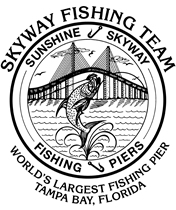Windy weather & passing storms shaped the week at the Sunshine Skyway Fishing Piers, but several species remained on very strong bites despite the heat and turbulent weather. Mangrove snapper are on one of their most consistent bites in many weeks, with limits of 12″ – 14″ fish becoming quite common for pier visitors – even during the daytime hours. Spanish mackerel remain in the vicinity of the piers, but anglers had to work a little harder for larger fish. Tarpon are again being spotted & hooked in the shadow line after dark. Gag grouper remained on a good bite, and some nice fish of legal length were taken. Sharks of various species & size classes were common this past week as well, with the smaller specimens primarily being sharpnose & blacktips and the larger ones being mostly spinner, nurse, bull and lemon sharks.
The strong winds did impact water clarity at the mouth of the Tampa Bay Estuary, but a smaller year class of scaled sardines appeared and these are like candy for mangrove snapper. Mangos are on an excellent bite on both fishing piers – especially on Gulf side artificial reefs during outgoing tides. The overnight hours are almost always best for snapper, but your author saw several very nice (14″+) fish taken this past week right in the middle of the daytime summer sunshine. Tackle & tactics remain simple snapper standards – with the only major choices being live bait style versus knocker rigging or octopus versus circle hooks. A traditional live bait style rig has the sinker suspended by a swivel above the hook by about 18″ – 24″ of leader material, while knocker-style allows the weight to rest directly against the eye of the hook. Octopus-style hooks involve setting on a fish whereas circle hooks set themselves with pressure from the fish. Anglers almost always use monofilament or fluorocarbon leader material in the 20 lb. – 40 lb. range – with lighter lines getting more bites and larger lines allowing greater snapper extraction from the reefs. A small scaled sardine threaded to completely cover the hook was top billing this past week.
Gag grouper went to a free-line bite, with pinfish & pigfish being top choices. Both incoming & outgoing tides can be fished free-line for gags, but outgoing tides are easier because incoming tides involve fishing underneath the older (closed) span of the pier. Some monster fish can be had by fishing underneath on incoming tides, but it is a tougher method, hook set, and fight. Hook pinfish and pigfish near the anal fin to get them to swim downwards and pay attention to whether the bait gets nervous. Often a strike is coming when the bait gets twitchy. Then put everything into getting the grouper away from the reef and on the pier. Even once the reef is avoided, flipper loves grouper as much as people!
Spanish mackerel remained on a decent bite at the piers, and the more dedicated mackerel hunters continued to well-outperform those only willing to spend a short time chasing these fish. Silver spoons fished behind a trolling weight were best. A casting bubble was also effective for lure use. The bubble is essentially a hollow plastic bobber that you place water inside and peg with either a swivel (or toothpicks) above your spoon, jig or other lure. The lure darts behind the bubble and the bubble gets way fewer ‘false strikes’ (and thus less bite-offs) than the ever-popular trolling-sinkers. Many anglers tweak & improve upon the bubble with superglue, clear tape, split-shot sinkers and beads. Some innovators have even begun to use smaller water bottles as ‘casting bubbles’ in much the same manner. On the flip side, anglers who prefer trolling-sinkers to present their offering often color the sinker black with a permanent marker to reduce false-strikes upon the weight itself. On the natural bait side, strips of sardines & herring fished with a split-shot sinker & long shank hook took plenty of mackerel.
Tarpon have made a strong mid-summer comeback at the piers. Fish of all sizes are seen rolling and striking baits along the piers during the daylight hours, but most of the silver king action occurs after dark. Look for tarpon on almost every light and in almost every shadow line for the next few months. A sure way to connect is to free-line live shrimp, sardines or herring to fish you see working the shadow line. Finally, for the tarpon you spot but cannot get to strike, place a weight above 6 feet of 80 lb. fluorocarbon and an 8/0 circle hook. Catch a smaller ladyfish and suspend the fish (with the weight remaining in the air) so that it struggles right at the surface where you have spotted an unwilling tarpon. Anchor the rod with medium drag for the hook-set, set the clicker and walk away. Even the most finicky tarpon can only take this presentation so long – most will eventually take the bait.
- The Skyway, Paul Bristow - August 24, 2018
- The Skyway, Paul Bristow - August 17, 2018
- The Skyway, Paul Bristow - August 10, 2018










